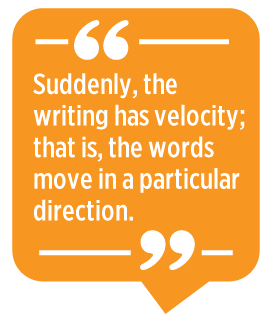6 Strategies to Improve Student Writing and Literacy
by Erik Thornquist

We as language teachers are expected to teach writing. The
research essay and position paper are staples of composition classrooms. At the
same time, students need to move beyond genre. How, then, can you teach
students to write? I’ve spent 25 years teaching and researching how to help
students move beyond the argumentative or cause-and-effect essay to just write.
At Be a Better Writer in 26
Lessons, my friend Rob MacKenzie and I present A through Z lessons
that boil writing down to its essentials. Each lesson is short and focused,
aimed at aspiring writers and language learners, and backed by a “learn”
exercise and a “use” exercise, because the best way to learn to write is…to
write. In this article, I address an idea that is mystical to many but in truth
totally teachable—the idea of flow. To make ideas
on the page flow like water, I teach my students to follow six simple
guidelines.
In setting
these guidelines for my students, I present them at three levels: at the
sentence level, from sentence to sentence, and at the paragraph level.
1. Use Active
Voice
At the
sentence level, start with this: (1) Make the person doing the
action (the actor) your subject whenever possible. Yes, I know
passive voice has its uses. However, even in technical and scientific writing,
statistics show that writers use passive voice far less than many
believe—usually to describe research methodology. In general, passive voice is
only used to vary sentence structure or when your actor is unknown or
unimportant. It often refers to an institution or a rule. At the same time,
behind the institution or rule, there’s a person pulling the lever—and a reader
will want to know who’s doing the pulling.
Making your
actor your subject reveals truth. Your reader knows not just the action but who
is accountable. Examine the following from the U.S.
Constitution and Dr.
Martin Luther King, Jr.:
|
Active Voice |
Passive
Voice |
|
We hold these
truths to be self-evident, that all men are created equal. (U.S.
Constitution) |
These truths are
self-evident, that all men are created equal (according to
whom). |
|
I had a dream.
(Dr. Martin Luther King, Jr.) |
A dream was had
(by whom). |
The versions on the right obscure; the ones on the
left reveal (both the who and the what). Good writing makes both actors
and action clear—and that starts with having a clear subject for each sentence.
2. Use Short Dependent
Clauses
The second
guideline focuses on readability: (2) Put any dependent clause
first and make it eight words or fewer. Noted composition
instructor Joseph Williams (2006) claims six, not eight, as his magic number. Readability
indexes also agree that shorter clauses and more frequent verbs make
a text more readable. Still, as a language teacher, I feel that anything less
than eight puts my learners in a hard spot. Later on, I allow my students to
“flip” the sentence—that is, put the dependent clause last—only if it presents
new information…but the eight-words-or-fewer guideline is constant.
 Students who
follow this guideline have to economize. Just as the 10-items-or-less line gets
you out of the supermarket quickly, the eight-words-or-fewer maxim forces your
student to get to the main clause quickly. Suddenly, the writing has velocity;
that is, the words move in a particular direction. This benefits your reader,
who only reads because of the promise that the words will go somewhere.
Students who
follow this guideline have to economize. Just as the 10-items-or-less line gets
you out of the supermarket quickly, the eight-words-or-fewer maxim forces your
student to get to the main clause quickly. Suddenly, the writing has velocity;
that is, the words move in a particular direction. This benefits your reader,
who only reads because of the promise that the words will go somewhere.
3. Focus on the
Psychological Subject
The next two
guidelines help a student go from sentence to sentence. In particular, (3) focus on the psychological
subject of each sentence. In short, know which noun or
noun phrase connects to the sentence before and the sentence after, which
may—or may not—be the actual subject of the sentence. To practice, give your
students the following sentences to develop into paragraphs:
- I know the solution is a good
one.
- They
met on the train.
First, have
students identify the nouns or noun phrases—in a) I, solution, good
one and in b) they and train. Then, ask them to expand each sentence into a
paragraph. To do this, they will use the next guideline.
4. Use Parallel or
Sequential Structures
(4) Use either parallel
or sequential structures.
The English language moves in one of two ways. The first is in parallel. A
sentence will have a topic (subject) and a comment (verb). In a parallel
structure, the next sentence will have the same topic but a new comment. The
second is sequential—that is, the first sentence will be Step 1, and the next
sentence, still tied to the psychological subject of the previous one, will be
Step 2. Let your students go back and forth between the parallel and
sequential, but for the words to flow, these are the only two moves they need
to learn. Here’s an example of parallel structure with the recurring topic in bold:
I
know the solution is a good one. I want my
students to make moves that an English-speaking audience will understand. When
I speak Arabic or Japanese, I think and arrange my
thoughts in a different way—and research supports this. Thus, I believe teaching parallel structure helps to
make the “code” of the English language clear.
Next, here’s
an instance of the sequential structure from 3b:
They met on the train,
where they had seats side by side. The ride was a peaceful one. The gentle
rocking motion of the train lulled both of them into sleep. When they woke up,
they realized they had fallen asleep while leaning against each other. First,
each apologized. Then, she joked about not knowing her ticket included a human
pillow. Both laughed, and the sound filled the train car.
We use these
structures not separately but in combination. As we read, I have students look
for these moves in passages as well. Even for dense texts, students who know
these two moves can, at minimum, read and follow a train of thought from
sentence to sentence and paragraph to paragraph. In this way, teaching the art
of clear writing will also make your students into better readers.
5. Understand Topic
Sentences
Now, let’s
define clear writing at the discourse level. Just like every sentence has a
topic (subject) and a comment (verb), (5) each paragraph has a
topic sentence (general) and a discussion (specific). Students
are traditionally taught to put the topic sentence first, but it works in a
number of places. The details in a paragraph could come first and then be
summed up by a topic sentence at the end. A paragraph could start with a
question, then the writer could flesh out the paragraph by addressing issues
and exploring options. One dramatic structure is the turnabout paragraph, one
in which the writer addresses details from the opposing view first before planting
a topic sentence in mid-paragraph and supporting it with details to finish with
a flourish.
6. Add a Summative
Sentence
Finally,
students need to know how to clarify the focus of a paragraph that is long or
has many or complicated ideas. To do this, have students help the reader by (6) adding a summative sentence at the end. A
student could make the paragraph circular by tying the topic at the end to the
topic at the beginning. Alternately, that last sentence could sum up the main
point in a simple subject-verb sentence. The writer can also give the reader a
takeaway, to “put a bow” on the ideas previously discussed. These six
guidelines set up your students for success—and knowing them will enhance a
student’s reading and literacy as well.
Helping Students
Succeed
For me, I
teach these six all at once. Later, I follow up by having students submit a
journal assignment in which they write to a topic and use the six guidelines.
To reinforce them, I later guide students through editing for “flow” by looking
at these same six items.
Now comes
the punchline. To make any piece of writing come alive, students need to
communicate emotion (authentic) and narrative (story and audience). Those two
are the spark and, alas, most often they come from inside. However, by teaching
these six guidelines, you can make sure that your students will have a clear
flow of language ready when inspiration strikes.
References
American
Rhetoric. (2020). Martin Luther King, Jr.: I have a dream. https://www.americanrhetoric.com/speeches/mlkihaveadream.htm
The National
Constitution Center. (2020). The U.S. Constitution: Full text. https://constitutioncenter.org/interactive-constitution/full-text
Williams, J.
M. (2006). Style: Ten lessons in clarity and grace.
Pearson Longman.
Further
Resources
Connor, U.
(1984). A study of cohesion and coherence in English as a second language
students’ writing. Paper in Linguistics,17(3), 301–316. https://doi.org/10.1080/08351818409389208
Hornby, P.
A., Hass, W. A., & Feldman, C. F. (1970). A developmental analysis of
the "psychological" subject and predicate of the sentence. Language and Speech, 13(3), 182–193. https://doi.org/10.1177/002383097001300304
Kaplan, R.
(1966). Cultural thought patterns in intercultural education.
Language Learning, 16(1), 1–2.
Klare, G. R., Rowe, P. P., John, M.
G., & Stolurow, L. M. (1969). Automation of the Flesch reading ease
readability formula, with various options. Reading Research
Quarterly, 4(4), 550. https://doi.org/10.2307/747070
Erik
Thornquist is a writing instructor and
researcher who currently lives and works in the United Arab Emirates. He has
presented at TESOL conferences around the world, has published journal articles
and book chapters, is the cofounder of the comedy collective YallaLaughs Abu
Dhabi, and is the cofounder of www.make-fire.com,
a website that makes the fundamentals of writing accessible for students and
teachers.